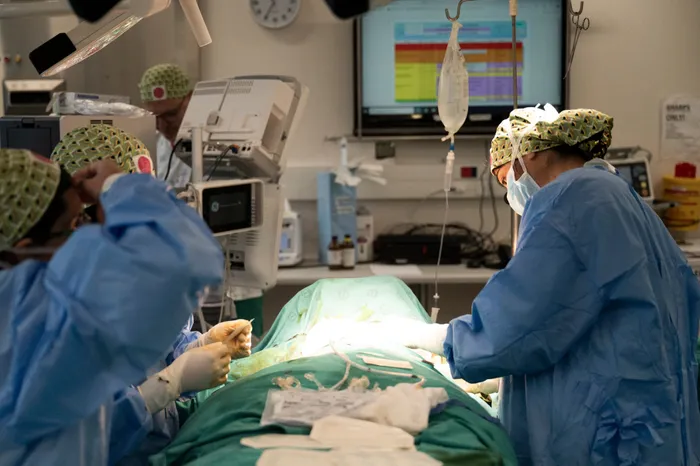Lack of education adds to medical care costs

Medical aid data indicates that there have been successes in preventative care uptake. Photographer: Armand Hough/Independent Newspapers
Nicola Mawson
A lower quality of life, longer treatment and recovery times, death and higher medical care costs are among the consequences of postponing a pap smear, blood test or prostrate exam.
Information from medical aid schemes shows, in glaring detail, where the health-care sector is making inroads, not just in medical advances, but also in preventative care: getting people to do routine scans or take that niggly feeling to the GP.
What it also shows, however, is where more intervention is needed to help alleviate the burden on the health-care system and trim costs overall.
In 2022, Profmed CEO Craig Comrie explained that health-care costs generally increased by between 3 and 4% above the inflation rate each year. An ageing demographic in the professional and medical scheme market adds to health-care inflation, said Comrie.
“This number of elderly people will continue to increase, which will put further strain on the health-care system and lead to rising costs.”
The skills shortage, too, is another factor that Comrie highlighted in a blog post on the medical aid’s website.
One that he did not mention, however, was a lack of education when it came to medical professionals getting patients to take advantage of preventative screening measures, the difficulty open medical aid schemes had in educating and encouraging a vast client base on the measures, as well as people simply not taking responsibility for those aspects of their health, Dr Johan van Zyl told Personal Finance.
Van Zyl, who advises health-care funders on the structure of benefits, said preventative care, which was about screening, leading to early diagnosis and treatment of illnesses such as cancer, was not being used enough.
“If one can diagnose these diseases earlier and treat them earlier, on average, they will be cheaper to treat.”
He said the cost of treatment when they were not picked up early was generally 20% higher at later stages.
The doctor said that many medical aid schemes offered such tests as an additional benefit, which meant that people were not depleting their savings or paying out of their pocket.
“It’s just a matter of people just not being aware of the fact that they have those benefits.”
There was also a fear factor involved in that people did not want to be screened and find out that they had, for example, cancer, Van Zyl said.
There are other reasons, too, why diseases weren’t being picked up early enough.
He said there were cases in which GPs did not push their patients to take the tests regularly.
Another issue was that was also easy for open medical aids to ensure their members were screened regularly because of the nature of their membership base. Schemes such as Discovery, Profmed, Momentum and the like were considered open schemes because anyone could join them, while those such as GEMS and Polmed were closed as they were available only to people in a certain industry, such as civil workers or the police.
Van Zyl said it was easier for closed schemes to drive awareness because they had a “captive audience”.
Medical aid data indicates that there have been successes in preventative care uptake, such as an increase in flu vaccine uptake among medical aid members over 65, from under 15% in 2013 to almost 20% in 2023.
Dr Unben Pillay, the CEO of the Alliance of South African Independent Practitioners Association, said that was thanks to a concerted effort by medical schemes and primary care doctors encouraging flu vaccination among patients.
There has also been a 25% increase in diabetes monitoring, supporting the effective management of diabetes patients. This is a welcome development, given that figures from the 2020 Mortality and Causes of Death report by Statistics South Africa identified diabetes, primarily Type 2, as the leading cause of death from natural causes (after Covid-19). By 2040, it is estimated that 8.75 million South Africans will be affected by diabetes.
However, there has been little progress in the number of women aged between 50 and 74 accessing mammography services, even though many medical aids have taken care to offer this at an affordable cost point. In addition, for those at higher risk, additional screenings such as MRI scans are available.
Another issue is that South Africa ranks 25th worldwide for asthma prevalence and fifth for asthma-related deaths. Yet, there has been a 3.5% decline in lung function testing for asthmatics since 2010, which is rather troubling. While nearly 50% of asthmatics are on controller therapy, compliance remains low.
The figures are from the Health Quality Assessment (HQA), a non-profit and public benefit organisation, which measured health-care quality across 83% of medical scheme members in South Africa. This encompasses more than 200 health quality indicators, including primary care, maternity and newborn care, chronic disease management and hospitalisation indicators.
The HQA’s 20th-consecutive annual Industry Report on the quality of health care in South Africa was based on data from medical schemes representing 104 benefit options and covering 83% of all insured beneficiaries, totalling 7.43 million lives. The analysis included a comprehensive review of 200 health quality indicators.
Van Zyl explained that among the costs of people not taking advantage of preventative screening was quality of life if the disease advanced. “Cancer, if you catch it early, is absolutely curable.”
He said there were financial benefits to medical aids in having members treated as soon as possible as well.
While there was no silver bullet to getting people to take advantage of screening offers, medical aids needed to constantly learn from collective experiences, which could also be applied to universal health care, Van Zyl said.
Otherwise, he said, costs were going to keep going up.
“If you don't measure yourself, then the entire bill will go up.”
PERSONAL FINANCE